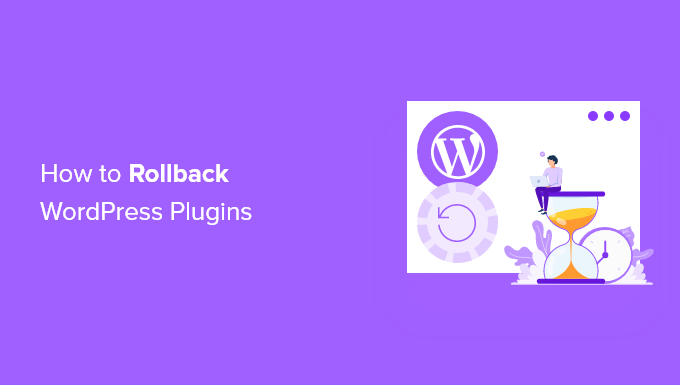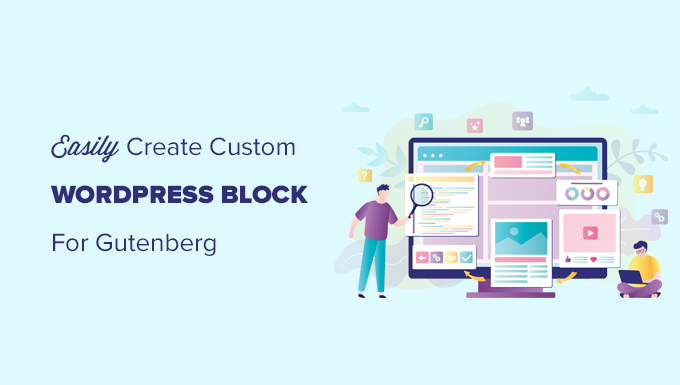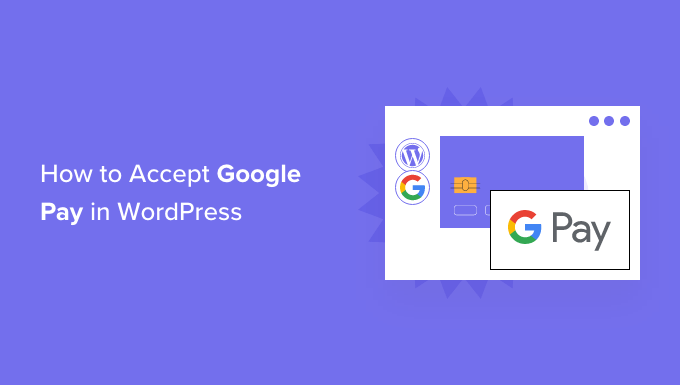Have you ever upgraded a Rollback WordPress plugin only to discover that the new version causes your site to malfunction?
This may be quite aggravating, and it’s one of the primary reasons Rollback WordPress why many novices fail to update plugins on a regular basis.
In this post, we’ll teach you how to use a version control system to rollback WordPress plugins for beginners.
When Do You Need to Rollback WordPress Plugins?
Keeping your WordPress website up to date is a good idea. That implies you should always utilise the most recent WordPress, plugin, and theme versions.
Updates can, however, damage your website on rare occasions. This can occur if the code has a bug or if the upgrade causes a clash with your theme or another plugin.
That’s why, before making any changes, you should always make a comprehensive backup of your WordPress site.
However, restoring your entire site from a backup can be time-consuming, and you risk losing any recent modifications you wish to save. Instead of restoring a backup, if you know which plugin caused the issue, you may quickly undo the modifications and report the issue to the developer, who will repair it.
You may also install the previous version of the plugin manually. However, if you can still log in to your WordPress admin area, rolling back the plugin version is a better option.
Let’s look at how to simply rollback WordPress plugins with a version control system meant for complete beginners. But first, we’ll teach you how to fix your website if you can’t log in because it’s broken.
What if You Can’t Get Into Your Website?
Reverting WordPress Plugins to an Older Version
Reverting WordPress Themes to an Older Version
What if You Are Locked Out of Your Website?
You must first log in to your website before you can rollback a plugin or theme.
But what if the new plugin or theme has entirely ruined your site, resulting in a catastrophic error or a white screen of death? Maybe your site is still up and operating, but you’re locked out of the WordPress admin panel?
You’ll have to manually deactivate your plugin or theme in those circumstances.
Deactivating WordPress Plugins Manually
If a plugin update has produced a major problem on your WordPress site, we recommend deactivating all plugins and then reactivating them one at a time.
If you can’t access wp-admin, read to our article on how to deactivate all plugins and use one of the two options to manually deactivate all of your plugins.
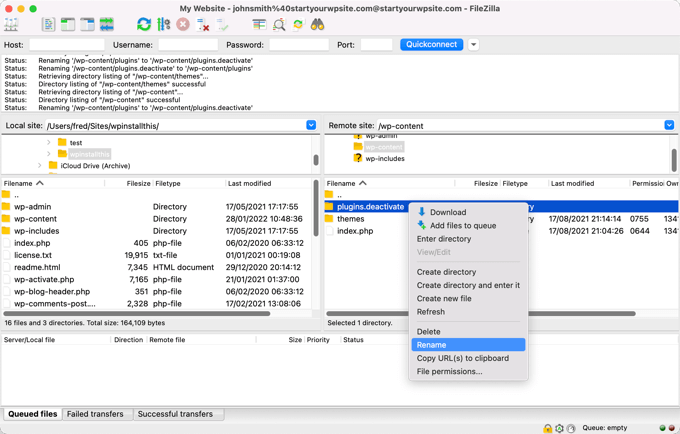
You should now be able to log in to your WordPress admin area. You can move on to the second section below and learn how to roll back the problem plugin to an earlier version. After that, you can reactivate your plugins one by one.
Deactivating WordPress Themes Manually
If your website troubles are caused by an updated theme, we recommend that you download a copy of the theme to your computer and then delete it.
You may find instructions on how to remove and delete a WordPress theme in our step-by-step tutorial. The instructions on how to prepare before removing a WordPress theme and how to delete the theme through FTP or the cPanel File Manager must be carefully followed.
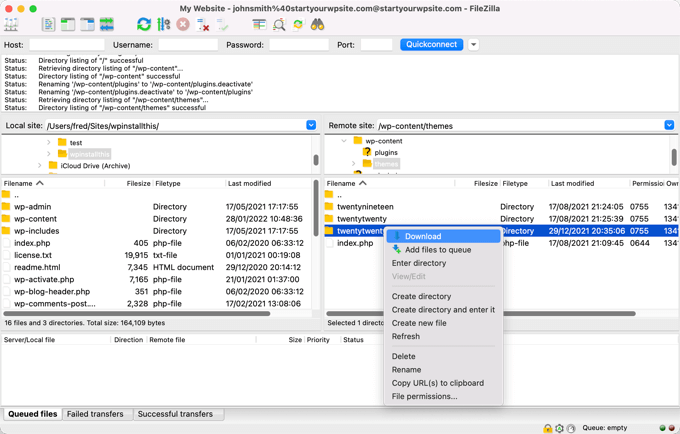
You should be able to log into your WordPress admin area again after that. To roll back the plugin to a prior version, first upload the theme folder from your computer to your website, and then scroll down to the third step below.
Are You Still Seeing an Error Message?
Whether you’re still having trouble getting into WordPress, make a note of the issue and check if our tutorial on what to do if you’re locked out of WordPress admin has a solution.
If not, have a look at our guide on the top 50 WordPress issues and how to solve them. More methods for getting help with the problem may be found in our article on how to properly ask for WordPress support.
Rolling Back a WordPress Plugin to a Previous Version
Installing and activating the WP Rollback plugin is the first step. See our step-by-step guide on installing a WordPress plugin for more information.
Go to Plugins > Installed Plugins after activation, and you’ll see a new ‘Rollback’ link beneath each plugin you installed from the WordPress.org plugin directory.
Third-party plugins that aren’t in the official WordPress plugin directory will not be able to be rolled back.

When you need to revert to a previous version of the plugin, simply visit the plugins page and click the ‘Rollback’ link below that plugin.
The WP Rollback plugin will take you to a page where you can see which version you have installed and the versions you can rollback to.
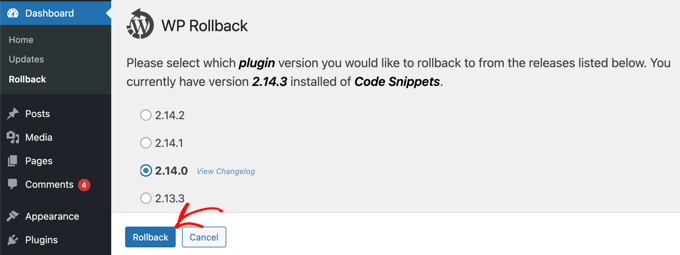
Simply select an older version and then click the ‘Rollback’ button.
The plugin will now display a warning message. This message simply informs you that you should create a complete WordPress backup before proceeding.
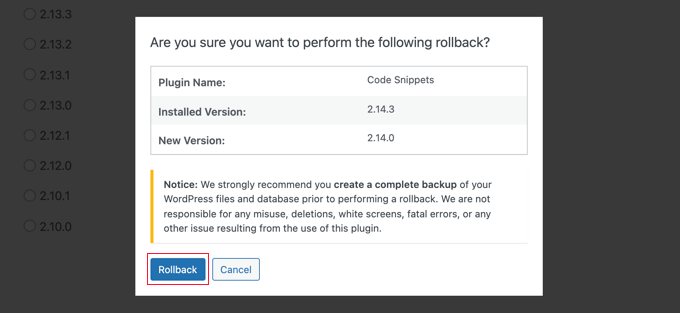
If you already have a recent backup of your WordPress site, then you can continue by clicking on the ‘Rollback’ button.
WP Rollback will download and replace your current version with the version you selected. Don’t forget to click the ‘Activate Plugin’ link when you’re ready.

Rolling Back WordPress Themes to Previous Version
If you’re using a free theme from the WordPress.org theme directory, WP Rollback can help you restore it.
Simply navigate to Appearance » Themes and choose the theme you wish to revert from the drop-down menu.
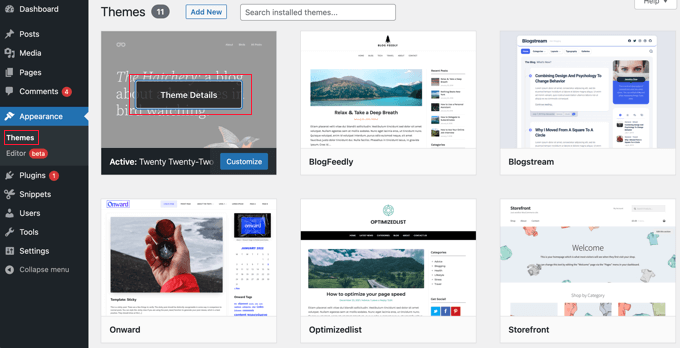
The ‘Theme Details’ box appears, displaying the plugin’s name and description, a link to activate auto-updates, and a button to adjust the theme.
In the bottom right corner, you’ll also find a ‘Rollback’ button.
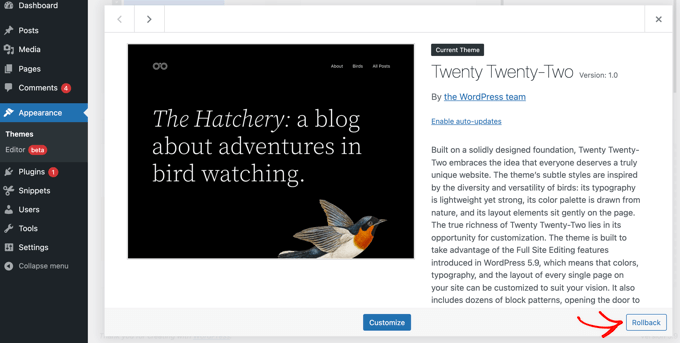
If you don’t see a rollback option, double-check that the theme you’re using is from the WordPress.org theme directory. The plugin is incompatible with themes obtained from other sources.
If you’re sure the theme you’re trying to uninstall is from the WordPress.org directory, all you have to do is go to the Dashboard » Updates page. WordPress will be forced to check for updates as a result of this.
Return to the themes page and select the theme you wish to revert to. The ‘Rollback’ option should now be available.
This will lead you to a page where you can see the current theme version as well as a list of previous versions to which you may revert.
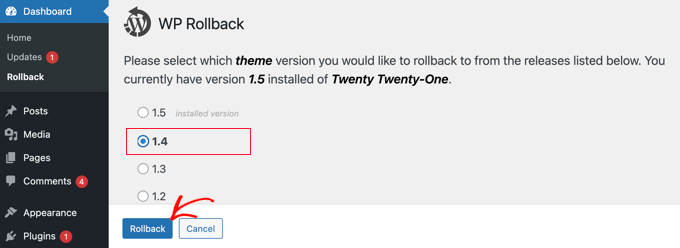
Simply select a previous version and then click the ‘Rollback’ button.
A warning message will be displayed reminding you to complete a backup before continuing.
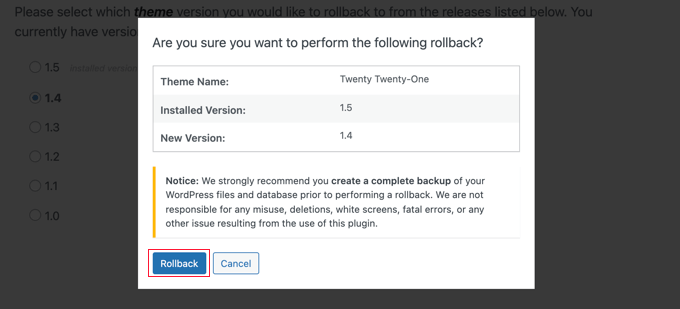
If you recently created a backup of your site, then you can safely click the ‘Rollback’ button.
The version of the theme you selected will be downloaded and replace the current version. If you want to use the theme on your website, then you should click the ‘Activate’ link.

We hope that this video taught you how to use a version control system to rollback WordPress plugins for beginners. You might also be interested in learning how to set up a free business email account or looking over our list of the most frequent WordPress mistakes and how to solve them.

